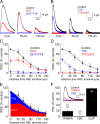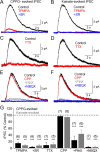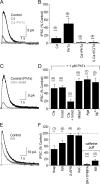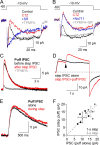Mechanisms underlying lateral GABAergic feedback onto rod bipolar cells in rat retina
- PMID: 20147559
- PMCID: PMC2836865
- DOI: 10.1523/JNEUROSCI.5574-09.2010
Mechanisms underlying lateral GABAergic feedback onto rod bipolar cells in rat retina
Abstract
GABAergic feedback inhibition from amacrine cells shapes visual signaling in the inner retina. Rod bipolar cells (RBCs), ON-sensitive cells that depolarize in response to light increments, receive reciprocal GABAergic feedback from A17 amacrine cells and additional GABAergic inputs from other amacrine cells located laterally in the inner plexiform layer. The circuitry and synaptic mechanisms underlying lateral GABAergic inhibition of RBCs are poorly understood. A-type and rho-subunit-containing (C-type) GABA receptors (GABA(A)Rs and GABA(C)Rs) mediate both forms of inhibition, but their relative activation during synaptic transmission is unclear, and potential interactions between adjacent reciprocal and lateral synapses have not been explored. Here, we recorded from RBCs in acute slices of rat retina and isolated lateral GABAergic inhibition by pharmacologically ablating A17 amacrine cells. We found that amacrine cells providing lateral GABAergic inhibition to RBCs receive excitatory synaptic input mostly from ON bipolar cells via activation of both Ca(2+)-impermeable and Ca(2+)-permeable AMPA receptors (CP-AMPARs) but not NMDA receptors (NMDARs). Voltage-gated Ca(2+) (Ca(v)) channels mediate the majority of Ca(2+) influx that triggers GABA release, although CP-AMPARs contribute a small component. The intracellular Ca(2+) signal contributing to transmitter release is amplified by Ca(2+)-induced Ca(2+) release from intracellular stores via activation of ryanodine receptors. Furthermore, lateral nonreciprocal feedback is mediated primarily by GABA(C)Rs that are activated independently from receptors mediating reciprocal feedback inhibition. These results illustrate numerous physiological differences that distinguish GABA release at reciprocal and lateral synapses, indicating complex, pathway-specific modulation of RBC signaling.
Figures






Similar articles
-
Reciprocal synaptic interactions between rod bipolar cells and amacrine cells in the rat retina.J Neurophysiol. 1999 Jun;81(6):2923-36. doi: 10.1152/jn.1999.81.6.2923. J Neurophysiol. 1999. PMID: 10368409
-
Diverse mechanisms underlie glycinergic feedback transmission onto rod bipolar cells in rat retina.J Neurosci. 2008 Jul 30;28(31):7919-28. doi: 10.1523/JNEUROSCI.0784-08.2008. J Neurosci. 2008. PMID: 18667624 Free PMC article.
-
Extrasynaptic NMDA Receptors on Rod Pathway Amacrine Cells: Molecular Composition, Activation, and Signaling.J Neurosci. 2019 Jan 23;39(4):627-650. doi: 10.1523/JNEUROSCI.2267-18.2018. Epub 2018 Nov 20. J Neurosci. 2019. PMID: 30459218 Free PMC article.
-
Retinal bipolar cells receive negative feedback input from GABAergic amacrine cells.Vis Neurosci. 1988;1(3):297-305. doi: 10.1017/s0952523800001954. Vis Neurosci. 1988. PMID: 2856476 Review.
-
Calcium-permeable AMPA and kainate receptors of GABAergic neurons.Biophys Rev. 2024 Apr 15;16(2):165-171. doi: 10.1007/s12551-024-01184-8. eCollection 2024 Apr. Biophys Rev. 2024. PMID: 38737208 Free PMC article. Review.
Cited by
-
Developmental regulation and activity-dependent maintenance of GABAergic presynaptic inhibition onto rod bipolar cell axonal terminals.Neuron. 2013 Apr 10;78(1):124-37. doi: 10.1016/j.neuron.2013.01.037. Neuron. 2013. PMID: 23583111 Free PMC article.
-
Two separate Ni(2+) -sensitive voltage-gated Ca(2+) channels modulate transretinal signalling in the isolated murine retina.Acta Ophthalmol. 2011 Nov;89(7):e579-90. doi: 10.1111/j.1755-3768.2011.02167.x. Epub 2011 Aug 23. Acta Ophthalmol. 2011. PMID: 21883984 Free PMC article.
-
Direct measurement of bipolar cell responses to electrical stimulation in wholemount mouse retina.J Neural Eng. 2018 Aug;15(4):046003. doi: 10.1088/1741-2552/aab4ed. Epub 2018 Mar 7. J Neural Eng. 2018. PMID: 29513646 Free PMC article.
-
Rod and cone interactions in the retina.F1000Res. 2018 May 23;7:F1000 Faculty Rev-657. doi: 10.12688/f1000research.14412.1. eCollection 2018. F1000Res. 2018. PMID: 29899971 Free PMC article. Review.
-
Cannabinoid Signaling Selectively Modulates GABAergic Inhibitory Input to OFF Bipolar Cells in Rat Retina.Invest Ophthalmol Vis Sci. 2020 Mar 9;61(3):3. doi: 10.1167/iovs.61.3.3. Invest Ophthalmol Vis Sci. 2020. PMID: 32150246 Free PMC article.
References
-
- Bloomfield SA. Relationship between receptive and dendritic field size of amacrine cells in the rabbit retina. J Neurophysiol. 1992;68:711–725. - PubMed
-
- Bloomfield SA, Völgyi B. Response properties of a unique subtype of wide-field amacrine cell in the rabbit retina. Vis Neurosci. 2007;24:459–469. - PubMed
Publication types
MeSH terms
Substances
Grants and funding
LinkOut - more resources
Full Text Sources
Molecular Biology Databases
Miscellaneous
